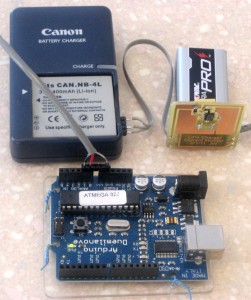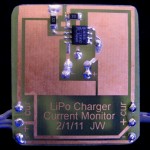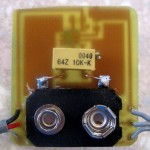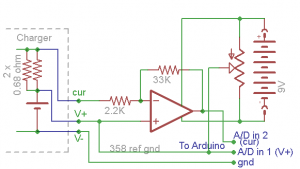 I had another board I needed to make, so I laid out a quickie for an LM358 based amp to let me measure current while charging Canon camera batteries with the connections I’d hacked into the charger a while ago. I took a chance and didn’t prototype it: I hoped I could design something with one opamp and a couple of resistors without screwing it up.
I had another board I needed to make, so I laid out a quickie for an LM358 based amp to let me measure current while charging Canon camera batteries with the connections I’d hacked into the charger a while ago. I took a chance and didn’t prototype it: I hoped I could design something with one opamp and a couple of resistors without screwing it up.
Only test so far is that I could set the ref gnd pot to null out the offset input so I get 0V between outputs to A/D channels 1 and 2 with the current sense input shorted to the “V+” input. This is obviously battery voltage dependent,
 but it won’t need to be done very many times.
but it won’t need to be done very many times.
The circuit is kind of strange, but I think it will work. The negative side of the camera battery goes straight thru to Arduino ground. Battery + goes straight thru to one A/D channel so the Arduino can measure battery voltage. Should never be > 4.2V or so, so the 5V range of Arduino input should be good. That battery + is also connected to “ground” of the current sense amp.  The current sense voltage is a small increment above V+, and gets amplified ~15 times and inverted by the opamp and is applied to the second A/D channel. The Arduino can measure that voltage (and thus compute the current) as a difference from the voltage it sees on the V+ channel.
The current sense voltage is a small increment above V+, and gets amplified ~15 times and inverted by the opamp and is applied to the second A/D channel. The Arduino can measure that voltage (and thus compute the current) as a difference from the voltage it sees on the V+ channel.
Next step is to verify operation of the sense amp and calibrate the it. I’ll apply say +0.2V on the current sense input with respect to “V+” in and verify I get about -3.0V on the A/D 2 pin with respect to A/D 1. Assuming that works, I’ll adjust the calibration constant in the Arduino code (which doesn’t exist yet). Let’s see – 0.2V across the 0.34 ohm current sense resistors is 0.588A. So I tweak the current calib constant for indication of ~0.588A.
I guess the code will look something like this:
- init A/D ports 0,1 for input with 5V range
- #define VoltCalib 5/1024 # 1024 counts in 10 bit A/D channel
- #define CurrCalib 0.588*VoltCalib/3 # guess: 3V -> .588A
Main Loop:
read A/D chan 0
BattVolt=AD0*VoltCalib
print battery voltage
read A/D chan 1
Current=(AD0 - AD1)*CurrCalib
print current
I have more pressing projects right now (like rebuilding a recording preamp/limiter so it’s ready to go for a square dance weekend in a couple of weeks), but this one will come up again…
UPDATE A FEW MINUTES LATER ON LOOKING AT THE BOARD LAYOUT:
Damn – assumption about being able to design something this simple without screwing up was wrong. I put the battery clip on backwards. Fixing that is pretty simple – swap the leads. But reversing the supply voltage to the opamp probably blew it out. I thought everything was ready to go when I got some time to do the next steps. Rats.
UPDATE AGAIN AN HOUR LATER…
I swapped the 9V leads and then couldn’t help myself – I checked out the amp. Sure enough, it was completely dead. I cut the old chip off and put a new one in. At least I got a little more practice with surface mount repair 😕 The good news is that it does in fact amplify – and about 15X, as designed. The bad news is that in addition to the implementation screw-up of reversed battery leads, I must have been on drugs when I thought moving the center point of the supply would let me null out the offset voltage. Specs on a 358 showed input offset voltage of up to a couple of mV. That’s what I was trying to null out. Hmm – the back of the envelope says with gain of 15 that would be an error of ~0.05V. With the calibration that 3V ->0.59A, it gives (0.05/3)*0.59, or about 10mA. I guess that’s not as bad as I thought. And that offset should be fairly constant, so worst case I could correct for it with an additive term in the code. OK, that’s not so bad, though I really didn’t have an extra hour to spend on this project.


Book marked, I really like your blog! 🙂